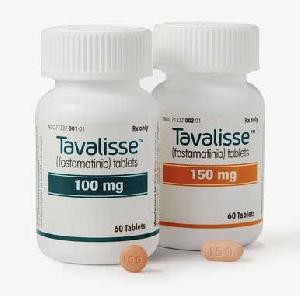Tavalisse Dosage
Generic name: FOSTAMATINIB 100mg
Dosage form: tablet
Drug class: Miscellaneous coagulation modifiers
Medically reviewed by Drugs.com. Last updated on Jan 2, 2024.
Recommended Dosage
Initiate TAVALISSE at a dose of 100 mg taken orally twice daily. After a month, if platelet count has not increased to at least 50 × 109/L, increase TAVALISSE dose to 150 mg twice daily.
Use the lowest dose of TAVALISSE to achieve and maintain a platelet count at least 50 × 109/L as necessary to reduce the risk of bleeding.
TAVALISSE may be taken with or without food. In the case of a missed dose of TAVALISSE, instruct patients to take their next dose at its regularly scheduled time.
Monitoring
After obtaining baseline assessments:
- Monitor CBCs, including platelet counts, monthly until a stable platelet count (at least 50 × 109/L) is achieved. Thereafter, continue to monitor CBCs, including neutrophils, regularly.
- Monitor liver function tests (LFTs) (e.g., ALT, AST, and bilirubin) monthly.
- Monitor blood pressure every 2 weeks until establishment of a stable dose, then monthly thereafter.
Dose Modification for Adverse Reactions
TAVALISSE dose modification is recommended based on individual safety and tolerability. Management of some adverse reactions may require dose-interruption, reduction, or discontinuation.
A dose reduction schedule is provided in Table 1, based on daily dose. For example, if a patient is on the maximum dose at the time of an adverse reaction, the first dose reduction would be from 300 mg/day to 200 mg/day.
| Daily Dose | Administered as: | |
|---|---|---|
| AM | PM | |
| 300 mg/day | 150 mg | 150 mg |
| 200 mg/day | 100 mg | 100 mg |
| 150 mg/day | 150 mg* | --- |
| 100 mg/day† | 100 mg* | --- |
The recommended dose modifications for adverse reactions are provided in Table 2.
| Adverse Reaction | Recommended Action |
|---|---|
| ALT = alanine aminotransferase; AST = aspartate aminotransferase; BP = blood pressure; BL = bilirubin; ULN = upper limit of normal; LFT = liver function tests (AST, ALT, total BL with fractionation if elevated, alkaline phosphatase); AST/ALT = AST or ALT | |
| Hypertension | |
| Stage 1: systolic between 130-139 or diastolic between 80-89 mmHg |
|
| Stage 2: systolic at least 140 or diastolic at least 90 mmHg |
|
| Hypertensive crisis: systolic over 180 and/or diastolic over 120 mmHg |
|
| Hepatotoxicity | |
| AST/ALT is 3 × ULN or higher and less than 5 × ULN | If patient is symptomatic (e.g., nausea, vomiting, abdominal pain):
|
If patient is asymptomatic:
|
|
| AST/ALT is 5 × ULN or higher and total BL is less than 2 × ULN |
|
| AST/ALT is 3 × ULN or higher and total BL is greater than 2 × ULN |
|
| Elevated unconjugated (indirect) BL in absence of other LFT abnormalities |
|
| Diarrhea | |
| Diarrhea |
|
| Neutropenia | |
| Neutropenia |
|
Dose Modification for Drug Interactions
Concomitant use with a strong CYP3A4 inhibitor increases exposure to R406 (the major active metabolite). Monitor for toxicities of TAVALISSE that may require TAVALISSE dose modifications (see Table 1) when given concurrently with a strong CYP3A4 inhibitor [see Drug Interactions (7.1)].
Discontinuation
Discontinue TAVALISSE after 12 weeks of treatment if the platelet count does not increase to a level sufficient to avoid clinically important bleeding [see Clinical Studies (14)].
More about Tavalisse (fostamatinib)
- Check interactions
- Compare alternatives
- Pricing & coupons
- Reviews (1)
- Drug images
- Side effects
- During pregnancy
- FDA approval history
- Drug class: miscellaneous coagulation modifiers
- Breastfeeding
- En español
Patient resources
Professional resources
Related treatment guides
Further information
Always consult your healthcare provider to ensure the information displayed on this page applies to your personal circumstances.

